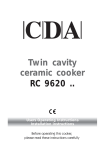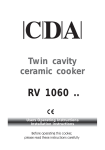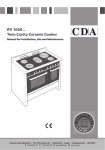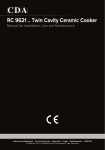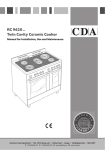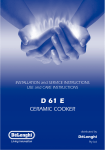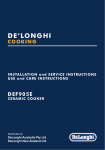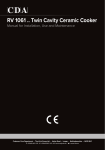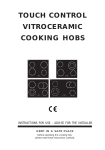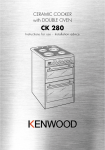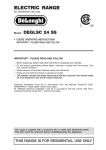Download DeLonghi Cooking hob Operating instructions
Transcript
Users Operating Instructions Before operating this cooker, please read these instructions carefully DSC 95 E Ceramic Cooker Introduction Congratulations on your purchase of this Delonghi ceramic cooker which has been carefully designed and produced to give you many years of satisfactory use. Before using this appliance it is essential that the following instructions are carefully read and fully understood. We would emphasise that the installation section must be fully complied with for your safety to ensure that you obtain the maximum benefits from your appliance. Important: This appliance is designed and manufactured solely for the cooking of domestic (household) food and is not suitable for any non domestic application and therefore should not be used in a commercial environment. The appliance guarantee will be void if the appliance is used within a non domestic environment i.e. a semi commercial, commercial or communal environment. 2 IMPORTANT INSTRUCTIONS AND ADVICE FOR THE USE OF ELECTRICAL APPLIANCES The use of any electrical appliance requires the compliance with some basic rules, namely: – do not touch the appliance with wet or damp hands (or feet) – do not use the appliance whilst in bare feet – do not allow the appliance to be operated by children or unqualified persons without supervision. The manufacturer cannot be deemed responsible for damages caused by wrong or incorrect use. IMPORTANT INFORMATION FOR CORRECT DISPOSAL OF THE PRODUCT IN ACCORDANCE WITH EC DIRECTIVE 2002/96/EC. At the end of its working life, the product must not be disposed of as urban waste. It must be taken to a special local authority differentiated waste collection centre or to a dealer providing this service. Disposing of a household appliance separately avoids possible negative consequences for the environment and health deriving from inappropriate disposal and enables the constituent materials to be recovered to obtain significant savings in energy and resources. As a reminder of the need to dispose of household appliances separately, the product is marked with a crossed-out wheeled dustbin. Declaration of CE conformity ✓ This cooker has been designed, constructed and marketed in compliance with: - Safety requirements of EU Directive "Low Voltage" 2006/95/EC; - Protection requirements of EU Directive "EMC" 89/336/EEC; - Requirements of EU Directive 93/68/EEC. 3 IMPORTANT SAFEGUARDS AND RECOMMENDATIONS After having unpacked the appliance, check to ensure that it is not damaged. In case of doubt, do not use it and consult your supplier or a professionally qualified technician. Packing elements (i.e. plastic bags, polystyrene foam, nails, packing straps, etc.) should not be left around within easy reach of children, as these may cause serious injuries. 4 ■ ATTENTION: please peel plastic cover off both sides and front of the cooker before use. ■ Do not attempt to modify the technical characteristics of the appliance as this may cause danger to users. ■ Do not carry out any cleaning or maintenance operations on the appliance without first disconnecting it from the electric power supply. ■ If you should decide not to use this appliance any longer (or decide to substitute an older model), before disposing of it, it is recommended that it is made inoperative in an appropriate manner in accordance to health and environmental protection regulations, ensuring in particular that all potentially hazardous parts be made harmless, especially in relation to children who could play with unused appliances. ■ After use, always ensure that the control knobs are in the off position. ■ The appliance is not intended for use by young children or infirm persons unless they have been adequately supervised by a responsible person to ensure that they can use the appliance safely. ■ During and after use of the cooker, certain parts will become very hot. Do not touch hot parts. ■ Young children should be supervised to ensure that they do not play with the appliance. ■ Some appliances are supplied with a protective film on steel and aluminium parts. This film must be removed before using the appliance. ■ WARNING When correctly installed, your product meets all safety requirements laid down for this type of product category. However special care should be taken around the rear or the underneath of the appliance as these areas are not designed or intended to be touched and may contain sharp or rough edges, that may cause injury. ■ Fire risk! Do not store flammable material in the oven or in the storage compartment. ■ Make sure that electrical cords connecting other appliances in the proximity of the cooker cannot come into contact with the hob or become entrapped in the oven door. ■ Do not line the oven walls with aluminium foil. Do not place baking trays or the drip tray on the base of the oven chamber. ■ The manufacturer declines all liability for injury to persons or damage to property caused by incorrect or improper use of the appliance. ■ The various components of the appliance are recyclable. Dispose of them in accordance with the regulations in force in your country. If the appliance is to be scrapped, remove the power cord. ■ Always use oven gloves when removing the shelves and food trays from the oven whilst hot. ■ Do not hang towels, dishcloths or other items on the cooker or its handle – as this could be a fire hazard. ■ Clean the oven regularly and do not allow fat or oils to build up in the oven base or trays. Remove spillages as soon as they occur. ■ Do not stand on the cooker or on the open oven door. ■ Always stand back from the cooker when opening the oven door to allow steam and hot air to escape before removing the food. ■ This appliance is for domestic use only. ■ WARNING: Taking care NOT to lift the cooker by the door handle. ■ Safe food handling: leave food in the oven for as short a time as possible before and after cooking. This is to avoid contamination by organisms which may cause food poisoning. Take particular care during warmer weather. ■ Do not allow heavy or sharp objects to drop on the glass ceramic hob. If the hob is cracked or otherwise damaged by falling objects etc., disconnect the electrical power cord and call Customer Service. ■ Do not scratch the hob with sharp objects. Don’t use the hob as a work surface. 5 1 Cooking hob 2 4 3 1 6 5 Fig. 1.1 VITROCERAMIC COOKING HOB 1. 3 circuits cooking zone Ø 180 2. 3 circuits cooking zone Ø 145 3. Oval double cooking zone Ø 145 x 250 4. Double cooking zone Ø 210/120 5. 3 circuits cooking zone Ø 145 6. Cooking zone residual heat indicators 1700 W 1200 W 1800/1000 W 2100/700 W 1200 W NOTE When the hob temperature is above 60 °C, the corresponding indicator light 6 (Fig. 1.1) will come on to indicate that the hob is hot. Attention: Do not use the ceramic hob if the glass surface is broken or cracked in any way. Please disconnect the appliance from the mains and contact the After-Sales service. 6 2 Control panel Fig. 2.1 10 9 P A U T O 1 2 3 4 5 6 7 8 CONTROL PANEL - Controls description 1. 2. 3. 4. 5. 6. 7. 8. Electronic programmer Multifunction oven switch knob Multifunction oven thermostat knob Front left cooking zone control knob Rear left cooking zone control knob Central cooking zone control knob Rear right cooking zone control knob Front right cooking zone control knob Pilot lamps: 9. Oven thermostat indicator light 10. Ceramic hob ON indicator light Please note: This appliance incorporates a safety cooling fan which you will hear operating whenever the oven or grill are in use. This fan is to reduce the external temperature of the appliance and cool the internal components. 7 3 Electronic programmer The electronic programmer is a device that groups together the following functions: – 24 hour clock with illuminated display – Timer (up to 23 hours and 59 minutes) – Programme for automatic oven cooking – Programme for semi-automatic oven cooking. Description of the buttons: Timer Automatic cooking taking place Timer in operation Cooking time End of cooking time Manual position and cancellation of the inserted cooking programme Advancement of the numbers of all programs Turning back of the numbers of all programs and changing the frequency of the audible signal. and AUTO - flashing - Programme error. (The time of day lies between the calculated cooking start and end time). N o t e : Select a function by the respective button and, in 5 seconds, set the required time with the / buttons (“one-hand” operation). A power cut zeroes the clock and cancels the set programmes. Description of the lighted symbols: AUTO - flashing - Programmer in automatic position but not programmed AUTO - always lighted - Programmer in automatic position with programme inserted. A U T O Fig. 3.1 8 Fig. 3.2 ELECTRONIC CLOCK (fig. 3.2) The programmer is equipped with an electronic clock with lighted numbers which indicate hours and minutes. Upon immediate connection of the oven or after a blackout, three zeroes will flash on the programmer panel. To set the hour it is necessary to push the button and then the or button until you have set the exact hour (fig. 3.2). Alternatively, simultaneously push the two buttons and at the same time push the or button. Note: Setting the clock deletes any programme. NORMAL COOKING WITHOUT THE USE OF THE PROGRAMMER To manually use the oven, that is, without the aid of the programmer, it is necessary to cancel the flashing AUTO by pushing the button (AUTO will be switched off and the symbol will go on - Fig. 3.3). Attention: If the AUTO is not flashing (which means a cooking programme has already been inserted), by pushing the button you have cancelled the programme and switched to manual. Fig. 3.3 ELECTRONIC TIMER The timer programme consists only of a buzzer which may be set for a maximum period of 23 hours and 59 minutes. If the AUTO is flashing push the button. To set the time, push the button and the or until you obtain the desired time (fig. 3.4). Having finished the setting, the normal time will appear on the panel and the symbol will appear. The countdown will start immediately and may be seen at any moment on the panel by simply pressing the button . At the end of the time, the symbol will be switched off and an intermittent buzzer will go off; this can be stopped by pressing any one of the buttons. ALTERING THE AUDIBLE SIGNAL By pressing the button you can choose from three variations. Fig. 3.4 9 AUTOMATIC OVEN COOKING To cook food automatically in the oven, it is necessary to: 1.Set the length of the cooking time 2.Set the end of the cooking time 3.Set the temperature and the oven cooking programme. These operations are done in the following way: 1.Set the length of the cooking time by pushing the button and the button to advance, or to go back if you have passed the desired time (fig. 3.5). The AUTO and the symbol will be on. 2.Set the end of the cooking time by pressing the button (the cooking time already added to the clock time will appear), and the button (fig. 3.6); if you pass the desired time you may get back by pushing the button. After this setting, the symbol will go off. If after this setting, the AUTO flashes on the panel and a buzzer goes off, it means there was an error in the programming. In this case, modify the end of cooking time or the cooking time itself by following the above instructions again. Fig. 3.5 10 3.Set the temperature and the cooking programme by using the switch and thermostat knobs of the oven (see specific chapters). Now the oven is programmed and everything will work automatically, that is the oven will turn on at the right moment to end the cooking at the established time. During cooking, the symbol remains on. By pushing the button you can see the time that remains until the end of cooking. The cooking programme may be cancelled in any moment by pushing . At the end of the cooking time the oven will turn off automatically, the symbol will turn off, AUTO will flash and a buzzer will sound, which can be turned off by pushing any of the buttons. Turn the switch and thermostat knobs to zero and put the programmer onto “manual” by pressing the button. Attention: A power cut makes the clock go to zero and cancels the set programmes. After a power cut three zeroes will flash on the panel. Fig. 3.6 SEMI-AUTOMATIC COOKING This is used to automatically switch off the oven after the desired cooking time has elapsed. There are two ways to set your oven: 1. Set the length of the cooking time by pushing the button and the button to advance, or to go backwards if you have passed the desired time (Fig. 3.7). At the end of cooking, the oven and the symbol will turn off, the AUTO will flash and a buzzer will sound; that can be stopped by pushing any of the buttons. Turn the switch and thermostat knobs to zero and put the programmer onto “manual” by pressing the button. or 2. Set the end of the cooking time by pushing the button and the button to advance, or to go backwards if you have passed the desired time (Fig. 3.8). AUTO and the symbol will be on. Then set the temperature and the cooking programme using the oven switch and thermostat knobs (see specific chapters). The oven is switched on and it will be switched off automatically at the end of the desired time. During cooking, the symbol remains on and by pressing the button you can see the time that remains till the end of the cooking. The cooking programme can be cancelled at any moment by pushing the button. Fig. 3.7 Fig. 3.8 11 4 How to use the vitroceramic hob The ceramic surface of the hob allows a fast transmission of heat in the vertical direction, from the heating elements underneath the ceramic glass to the pans sat on it. The heat does not spread in the horizontal direction, so that the glass stays “cool” at only a few centimeters from the cooking plate. The 5 cooking plates are shown by painted disks on the ceramic surface. IMPORTANT NOTE: The heating elements incorporate a thermolimiter that switches the element ON/OFF during all the settings to protect the ceramic glass from overheating. The use of incorrect pans and/or wrong pan positioning will cause the temperature limiter to operate more frequently, resulting in a reduction of cooking performance. 3 CIRCUIT RADIANT ZONES Incorporating 3 heating elements (fig. 4.2) you can control and light up all 3 together or separately by selecting from the 6 positions on the control knob (fig. 4.1). The working temperature required is reached in a very short time. Fig. 4.1 12 Fig. 4.2 DOUBLE AND OVAL RADIANT ZONES The heating element is formed of a coil of resistant material which reaches the working temperature quickly. Operation of the cooking zone is controlled by a continuous energy regulator from 1 to 12 (maximum temperature) (fig. 4.3). To turn on both zones of the double element, turn the double element knob fully clockwise to the position . To reduce the heat of the full double element, turn its knob anticlockwise to setting 12 or lower. Adjust the heat during cooking as necessary. Note: if you leave the knob at the position, the full double element will remain at the highest heat setting. To return to using only the inner zone of the double element, first turn the knob to the 0 (off) position (you should feel a click) and then clockwise to a setting from 1 to 12. Fig. 4.3 Second element Fig. 4.4 Second element Fig. 4.5 13 COOKING HINTS Cooking zone controlled by a 7 position switch Cooking zone controlled by a 12 position energy regulator 1 1 2 Knob setting 0 0 Switched OFF 1 2 For melting operations (butter, chocolate). 4 1 2 2 2 3 4 To maintain food hot and to heat small quantities of liquid (sauces, eggs). 4 5 6 To heat bigger quantities; to whip creams and sauces. (vegetables, fruits, soups). 3 6 4 7 Slow boiling, i.e.: boiled meats, spaghetti, soups, continuations of steam cooking of roasts, stews, potatoes. 4 7 8 For every kind of frying, cutlets, uncovered cooking, i.e.: risotto. 8 4 9 5 10 Browning of meats, roasted potatoes, fried fish, omelettes, and for boiling large quantities of water. 6 11 12 Fast frying, grilled steaks, etc. 3 2 3 5 3 6 7 8 4 9 10 5 11 12 6 Type of cooking Switching on the second element (Double and oval radiant zones only) Heating Cooking After a short period of use, experience will teach you which setting is the right one for your needs. Roasting-frying Fig. 4.6 14 RESIDUAL HEAT INDICATORS COOKING HINTS: The hob also features 5 warning lights which are connected to the corresponding plates. When the temperature of a cooking plate is above 60 °C, the relevant warning light will also light up to warn of heat on the surface of the hob. This light also stay on after the cooking plate has been switched off to show that the hob surface is still hot. This residual heat will lasts for a long time after the cooking plate has been switched off. During this time you should avoid touching the hob surface over the cooking area. Please pay special attention to ensure that children are not allowed near the hob. The light will switch off automatically as soon as the surface temperature of the cooking plate falls below 60°C. – To reduce the cooking time, you can turn the control knob to the max when you switch the plate on. After a short time you can set the control knob to the position required for cooking. – You should only use pots and pans with flat bases (pans with the test mark for glass-ceramic hobs are available from specialist shops). The diameter of the pan should match that of the cooking plate (or be slightly bigger) to make the most of the energy. – Since the cooking surface will stays hot for a certain time after the plate has been switched off, you can switch it off 5 or 10 minutes before the end of the cooking. The residual heat of the hob will complete the cooking. – To save electricity, use pan lids whenever possible. – Never cook the food directly on the glass ceramic hob, but in special pans or containers. – Do not scratch the cooktop with cutting or sharp objects. Do not use the glass ceramic surface as a work surface. Caution! the cooking hob becomes very hot during operation. Keep children well out of reach. DEEP FAT FRYING Fig. 4.7 DO NOT USE GLASSWARE ON CERAMIC HOBS. DO NOT USE PANS WITH ROUGH CIRCULAR MACHINED BASE. For safety purposes when deep fat frying, do not fill the pan more than one third full of oil. DO NOT cover the pan with a lid and DO NOT leave the pan unattended. In the unfortunate event of a fire, leave the pan where it is and turn off the control knobs. Place a damp cloth or lid over the pan to smother the flames. Leave the pan to cool for at least 30minutes before moving the pan. DO NOT USE WATER ON THE FIRE. 15 SAFETY HINTS: CLEANING THE HOB – Before you switch the hob on, make sure you know which knob controls the required cooking plate. We advise you to set the pan over the cooking plate before switching it on. Remove the pan after you have switched the cooking plate off. – Do not use pots and pans with rough bases (pay attention to cookware made of cast-iron). Rough bases can damage (scratch) the glass surface of the hob. Make sure that the bottom of the pan is dry and clean. – Pots with aluminium bottoms may leave silver streaks or spots on the hob. – Do not leave wet or damp lids on the hob. – The glass-ceramic surface and pans must be clean. Carefully remove any food debris (especially containing sugar), dirt etc. with the aid of a cleansing agent. – Pan handles should never stand out beyond the kitchen worktop, as there is a great danger of knocking the pan over. This will also ensure that children cannot reach them. – Do not use the hob if the glass surface is broken or cracked in any way. Please disconnect the cooker from the mains and contact the after-sales service. – Do not lean over the cooking plate when in use. – Do not lay cooking foil or plastic materials on the ceramic surface when it is hot. – Remember that the surface remains hot for a long time (about 30 min.) after the cooking plate has been switched off. – Follow the cleaning instructions carefully. Before you begin cleaning make sure that the appliance is switched off. Do not use the glass surface for storage. 16 Remove spillages and other types of incrustations. Dust or food particles can be removed with a damp cloth. If you use a detergent, please make sure that it is not abrasive or scouring. Abrasive or scouring powders can damage the glass surface of the hob. All traces of the cleaner must be removed with a damp cloth. Do not put articles on the hob which can melt: i.e plastic, aluminium foil, sugar, sugar syrup mixtures etc. If any of these products items have melted on the ceramic surface, you should remove it immediately (when the surface is still hot) by using a scraper to avoid any permanent damage to the surface of the hob. (Available under part No. 103138). Avoid using a knife or other sharp utensils since these can damage the ceramic. Do not use steel wool or an abrasive sponge which could scratch the surface permanently. ATTENTION: MOST IMPORTANT! If cleaning the glass ceramic hob using a special scraper tool take extra care to avoid damaging the seal at the edges of the glass ceramic surface. Fig. 4.8 5 Multifunction oven Attention: the oven door becomes very hot during operation. Keep children away. GENERAL FEATURES As its name indicates, this is an oven that presents particular features from an operational point of view. In fact, it is possible to insert 7 different programs to satisfy every cooking need. The 7 positions, thermostatically controlled, are obtained by 4 heating elements which are: – Bottom element 1725 W – Top element 1725 W – Grill element 2500 W – Circular element 2200 W NOTE: Upon first use, it is advisable to operate the oven for 30 minutes in the position and for another 30 minutes at the maximum temperature (thermostat knob on position 250) in the positions and , to eliminate possible traces of grease on the heating elements. Clean the oven and accessories with warm water and washing-up liquid. OPERATING PRINCIPLES Heating and cooking in the MULTIFUNCTION oven are obtained in the following ways: a. by normal convection The heat is produced by the upper and lower heating elements. b. by forced convection The fan draws in air contained within the oven housing at the rear of the oven and forces it over the circular heating element. The hot air envelops the food in the oven givin faster and more even cooking before it is drawn back into the housing to repeat the cycle. It is possible to cook several dishes simultaneously due to the even distribution of heat within the oven. c. by forced semi-convection The heat produced by the top and bottom heating elements is distributed throughout the oven by the fan. d. by radiant heat The food is grilled by the infra red grill element. e. by radiant heat and ventilation The food is grilled by the grill element is distributed throughout the oven f. by ventilation The food is defrosted by using the fan only function without heat. WARNING: The door is hot, use the handle. ATTENTION - MOST IMPORTANT Pay special attention not to touch the hot heating element inside the oven cavity. 17 Fig. 5.1 Fig. 5.2 THERMOSTAT KNOB (Fig. 5.2) This only sets the cooking temperature and does not switch the oven on. Rotate clockwise until the required temperature is reached (from 50 to 250 °C). The light above the temperature selector will illuminate when the oven is swiched on and turns off when the oven reaches the correct temperature. The light will cycle on and off during cooking in line with the oven temperature. FUNCTION SELECTOR KNOB (Fig. 5.1) Rotate the knob clockwise to set the oven for one of the following functions. OVEN LIGHT By setting the knob to this position, only the oven light comes on. It remains on in all the cooking modes. TRADITIONAL CONVECTION COOKING The upper and lower heating elements come on. The heat being dispersed by natural convection. The temperature range must be set between 50 °C and 250 °C using the thermostat. The oven must be preheated before cooking. Recommended for: Food that requires the same degree of cooking both inside and out, for example roasts, spare pork ribs, meringues etc. 18 GRILLING The infrared grill element comes on. The heat is dispersed by radiation. Set the thermostat knob to between 50 °C and 200 °C. Always grill with the oven door closed. For cooking hints, see the chapter “USE OF THE GRILL”. Recommended for: Intense grilling, browning, cooking au gratin and toasting etc. Do not grill for longer than 30 minutes at any one time on full heat (200 °C). Caution: the oven door becomes very hot during operation. Keep children well out of reach. DEFROST Only the oven fan comes on. Use with the thermostat knob set to “ ” - other temperature have no effect. The food is thawed by ventilation without heating. Recommended for: Quick thawing of frozen foods; one kg requires approximately 1 hour. Thawing times vary according to the quantity and type of food to be thawed. FAN FORCED The circular element and fan come on. The heat is dispersed by forced convection and the temperature can be varied to between 50 °C and 250 °C via the thermostat knob. The oven does not require preheating. Recommended for: Food which has to be well-cooked outside and soft or rosy inside, for example lasagne, lamb, roast beef, whole fish etc. FAN GRILL Both the grill and the fan come on. Most of the cooking is done by grilling and then the hot air circulated around the oven. The oven door should be kept closed. The temperature can be set between 50 °C and 175 °C max. The oven should be preheated for 5 minutes before cooking. For further cooking hints see “GRILLING AND COOKING AU GRATIN”. Recommended for: Quick sealing in of food juices for example such as hamburger, chicken pieces, chops. Do not grill for longer than 30 minutes at any one time on full heat (175 °C). Caution: the oven door becomes very hot during operation. Keep children well out of reach. 19 MAINTAINING TEMPERATURE AFTER COOKING OR SLOWLY HEATING FOODS The upper element, the circular element and the fan come on. The heat is circulated by forced convection with greater intensity in the upper part. The temperature can be set to between 50 °C and 140 °C via the thermostat knob. Recommended for: Keeping food warm after any type of cooking. Slow heating of cooked food. MULTI-FUNCTION The upper and lower heating elements come on and the fan come on - the heat from the element being circulated by the fan. The temperature range can be set to between 50 °C and 250 °C using the thermostat. Recommended for: Large bulky quantities of food that require even cooking throughout for example large roasts, turkey, roast turkey, cakes etc. COOKING ADVICE Remember to keep children away from the appliance when you use the grill or oven, since these parts become very hot. STERILIZATION Sterilization of foods to be preserved, in full and hermetically sealed jars, is done in the following way: a. Set the switch to position . b. Set the thermostat knob to position 185 °C and preheat the oven. c. Fill the dripping pan with hot water. d. Set the jars onto the dripping pan making sure they do not touch each other and the door and set the thermostat knob to position 135 °C. When sterilization has begun, that is, when the contents of the jars start to bubble, turn off the oven and let cool. Check your recycle book for full instructions. 20 WARMING BREAD Set the switch to position and the thermostat knob to position 150 °C. Bread becomes fragrant again if wet with a few drops of water and put into the oven for about 10 minutes at the highest temperature. SIMULTANEOUS COOKING OF DIFFERENT FOODS The oven set on position can cook several different foods together. Foods as diverse as fish and cakes can be cooked together without the cross transference of flavours. This is because the fats and cooking smell that would normally be deposited on the different foods are oxidised and are not absorbed by the foods. The cooking temperature of the foods, however must be within 20 - 25 °C of each other. The food with the longest cooking time will be put into the oven first and the other foods are added as necessary according to their cooking times. ROASTING To obtain classical roasting, it is necessary to remember: ■ that it is advisable to maintain a temperature between 180 °C and 200 °C. ■ that the cooking time depends on the quantity and the type of foods. GRILLING AND COOKING AU GRATIN As the hot air completely covers the food to be cooked, grilling may be done with the food on the rack in the oven. The knob should be switched to position . The thermostat should be set to 50 °C and 175 °C max and the oven pre-heated. The food should be placed on a rack in the oven for the required cooking time. Adding a few dabs of butter before the end of the cooking time gives the golden “au gratin” effect. USE OF THE GRILL Preheat the oven for about 5 minutes with the door closed. Introduce the food to be cooked, positioning the rack as close to the grill as possible. The dripping pan should be placed under the rack to catch the cooking juices and fats. WARNING: Accessible parts may become hot when the grill is used. Children should be kept away. 21 6 Cooking guide Temperature and times given are approximate, as they will vary depending on the quality and amount of food being cooked. Remember to use ovenproof dishes and to adjust the oven temperature during cooking if necessary. APPROX. TEMPERATURE HEAT OF TYPE OF DISH TO COOK OVEN 125°C (257°F) Very cool oven Meringue, slow cooking foods. 135°C - 140°C (275°F - 285°F) Cool or slow oven Milk puddings, very rich fruit cakes, eg., Christmas. 150°C (300°F) Cool or slow oven Stews, casseroles, braising, rich fruit cakes, eg., Dundee. Warm oven Biscuits, Low temperature roasting, rich plain cakes eg., Madeira cake. 180°C (356°F) Moderate oven Plain cakes, eg., Victoria sandwich, meat pies. 190°C (374°F) Fairly hot oven Small cakes, savoury flans, fish. 200°C (392°F) Hot oven Plain cakes and buns, swiss rolls, fruit pies. High temp. roasting. 215°C (419°F) Moderately hot oven Bread and bread rolls etc., scones, flaky and rough puff pastry, Yorkshire pudding. 225°C (437°F) Very hot oven Sausage rolls, mince pies, puff pastry. Browning ready cooked dishes. 160°C - 170°C (320°F - 338°F) 22 Important notes Installation, and any demonstration, information or adjustments are not included in the warranty. The cooker must be installed by a qualified person in accordance with the relevant Standards. Attention The appliance gets very hot, mainly around the cooking areas. It is very important that children are not left alone in the kitchen when you are cooking. AFTER SALES SERVICE Should you require to book a service call telephone 0870 5425425. For product information and advise telephone 0113 2793520 23 Do’s and do not’s • Do always grill with the oven door closed. • Do read the user instructions carefully before using the cooker for first time. • Do allow the oven to heat for one and a half hours, before using for the first time, in order to expel any smell from the new oven insulation, without the introduction of food. • Do clean your oven regularly. • Do remove spills as soon as they occur. • Do always use oven gloves when removing food shelves and trays from the oven. • Do not allow children near the cooker when in use. • Do not allow fat or oils to build up in the ovens trays, or oven base. • Do not place cooking utensils or plates directly onto the oven base. • Do not grill food containing fat without using the grid. • Do not cover the grilling grid with aluminium-foil. • Do not use the oven tray for roasting. • Do not place hot enamel parts in water. Leave them to cool first. • Do not allow vinegar, coffee, milk, saltwater, lemon or tomato juice to remain in contact with enamel parts (inside the oven and on the oven tray). • Do not use abrasive cleaners or powders that will scratch the surface of the stainless steel and the enamel. • Do not attempt to repair the internal workings of your cooker. • Do remove the protective film before the first use. • Fire risk! Do not store flammable material in the oven and in the storage compartment. FOR YOUR SAFETY The product should only be used for its intended purpose which is for the cooking of domestic foodstuffs. Under no circumstances should any external covers be removed for servicing or maintenance except by suitably qualified personnel. 24 7 Cleaning and maintenance GENERAL ADVICE As a safety measure, before you start cleaning the cooker be sure to disconnect it from the mains supply. Do not use a steam cleaner because the moisture can get into the appliance thus make it unsafe. The use of suitable protective clothing/gloves is recommended when handling or cleaning of this appliance. WARNING When correctly installed, your product meets all safety requirements laid down for this type of product category. However special care should be taken around the rear or the underneath of the appliance as these areas are not designed or intended to be touched and may contain sharp or rough edges, that may cause injury. SPILLAGE Any spillage should be dealt with as soon as possible to prevent it becoming burnt on. VITROCERAMIC COOKING HOB - See page 16. ENAMELLED PARTS All the enamelled parts must be cleaned with a sponge and soapy water or other non-abrasive products. Dry preferably with a microfibre or soft cloth. Acidic substances like lemon juice, tomato sauce, vinegar etc. can damage the enamel if left in contact for too long. STAINLESS STEEL, ALUMINIUM PARTS AND SILK-SCREEN PRINTED SURFACES Clean using an appropriate product. Always dry thoroughly. IMPORTANT: these parts must be cleaned very carefully to avoid scratching and abrasion. You are advised to use a soft cloth and neutral soap. CAUTION: Do not use abrasive substances or non-neutral detergents as these will irreparably damage the surface. 25 OVEN DOOR STORAGE COMPARTMENT The internal glass panel can be easily removed for cleaning by unscrewing the 4 retaining screws (Fig. 7.1). The storage compartment is accessible through the pivoting panel (fig. 7.2). Do not use harsh abrasive cleaners or sharp metal scrapers to clean the oven door glass since they can scratch the surface, which may result in shattering of the glass. Do not store flammable material in the oven or in the storage compartment. Fig. 7.1 Fig. 7.2 26 INSIDE OF OVEN The oven should always be cleaned after use when it has cooled down. The cavity should be cleaned using a mild detergent solution and warm water. Suitable proprietary chemical cleaners may be used after first consulting with the manufacturers recommendations and testing a small sample of the oven cavity. Abrasive cleaning agents or scouring pads/cloths should not be used on the cavity surface. • NOTE: The manufacturers of this appliance will accept no responsibility for damage caused by chemical or abrasive cleaning. Attention: Do not store flammable material in the oven. Fig. 7.3 ASSEMBLY AND DISMANTLING OF THE SIDE RUNNER FRAMES – Fit the side runner frames into the holes on the side walls inside the oven (Fig. 7.3). – Slide the tray and rack into the runners (Fig. 7.4). The shelf must be fitted so that the safety catch, which stops it sliding out, faces the inside of the oven. – To dismantle, operate in reverse order. Fig. 7.4 REPLACING THE OVEN LIGHT BULB Switch the cooker off at the mains. When the oven is cool, unscrew and replace the bulb with another one resistant to high temperatures (300°C), voltage 230 V (50 Hz), E14 and same power (check watt power as stamped in the bulb itself) of the replaced bulb. Note: Oven bulb replacement is not covered by your guarantee. 27 OVEN TRAY The oven tray must be correctly placed on the wire support (fig. 7.5) then inserted into the side runners (fig. 7.6). OVEN FLOOR The oven floor “F” (fig. 7.6) can be easily removed to facilitate cleaning. Remember to replace the floor correctly afterwards. Be careful not to confuse the tray “L” with the oven floor “F”. Fig. 7.5 L F Fig. 7.6 28 REMOVING THE OVEN DOORS Fig. 7.7A The oven doors can easily be removed as follows: – Open the door to the full extent (fig. 7.7A). – Attach the retaining rings to the hooks on the left and right hinges (fig. 7.7B). – Hold the door as shown in fig. 7.7. Fig. 7.7B – Gently close the door and withdraw the lower hinge pins from their location (fig. 7.7C). – Withdraw the upper hinge pins from their location (fig. 7.7D). – Rest the door on a soft surface. – To replace the door, repeat the above steps in reverse order. Fig. 7.7C Fig. 7.7D Fig. 7.7 29 Advice for the installer IMPORTANT – Cooker installation must only be carried out by QUALIFIED TECHNICIANS and in compliance with local safety standards. Failure to observe this rule will invalidate the warranty. – Some appliances are supplied with a protective film on steel and aluminium parts. This film must be removed before using the cooker. – Important: the use of suitable protective clothing/gloves is recommended when handling or installing of this appliance. 30 8 Installation Important – The appliance should be installed by a qualified electrician in compliance with the laws in force in your country and in observation of the instructions supplied by the manufacturer. Failure to comply with this condition will render the guarantee invalid. – Always disconnect the cooker from mains power supply before carrying out any maintenance operations or repairs. The cooker must be installed no less than 50 mm away from any side wall which exceed the height of the cooktop; The appliance must be housed in heat resistant units. The walls of the units must be capable of resisting temperatures of 75 °C above room temperature. Do not install the appliance near inflammable materials (eg. curtains). 450 mm 750 mm If the cooker is located on a pedestal it is necessary to provide safety measures to prevent falling out. 50 mm 500 mm A U T O Fig. 8.1 31 FITTING THE ADJUSTABLE FEET The adjustable feet must be fitted to the base of the cooker before use. Rest the rear of the cooker on a piece of the polystyrene packaging exposing the base for the fitting of the feet. Fig. 8.2 Fit the 4 legs by screwing them tight into the support base as shown in picture 8.3. Fig. 8.3 LEVELLING THE COOKER The cooker may be levelled by screwing the lower ends of the feet IN or OUT (fig. 8.4). Fig. 8.4 32 MOVING THE COOKER WARNING When raising cooker to upright position always ensure two people carry out this manoeuvre to prevent damage to the adjustable feet (fig. 8.5). WARNING Be careful: do not lift the cooker by the door handle when raising to the upright position (fig. 8.6). Fig. 8.5 WARNING When moving cooker to its final position DO NOT DRAG (fig. 8.7). Lift feet clear of floor (fig. 8.5). Fig. 8.6 Fig. 8.7 33 Stability bracket We recommend a stability bracket is fitted to the cooker. The type shown in fig. 8.8 can be purchased from most plumbers merchants and do it yourself (D.I.Y.) shops. Existing slot in rear of cooker Bracket Fig. 8.8 Dotted line showing the position of cooker when fixed 3 Outline of cooker backplate at the engagement slot Wall fixing Floor fixing Dimension is in millimetres 34 9 Electrical section IMPORTANT: The cooker must be installed in accordance with the manufacturer’s instructions. Incorrect installation, for which the manufacturer accepts no responsibility, may cause injury to persons, animals or equipment. FOR YOUR SAFETY PLEASE READ THE FOLLOWING INFORMATION: – Connection to the mains must be carried out by qualified technician in accordance with current regulations. – The appliance must be connected to the mains checking that the voltage corresponds to the value given in the rating plate and that the electrical cable sections can withstand the load specified on the plate. – The cooker can be connected directly to the mains placing an omnipolar switch with minimum opening between the contacts of 3 mm between the appliance and the mains. – The power supply cable must not touch any hot parts and must be positioned so that it does not exceed 75°C at any point. – Once the cooker has been installed, the switch must always be accessible. N.B. For connection to the mains, do not use adapters, reducers or branching devices as they can cause overheating and burning. If the installation requires alterations to the domestic electrical system, call an expert. He should also check that the domestic electrical system is suitable for the power absorbed by the appliance. – The connection of the appliance to earth is mandatory. The manufacturer declines all responsability for any inconvenience resulting from the none observance of this condition. IMPORTANT: this cooker must be connected to a suitable double pole control unit adjacent to the cooker. No diversity can be applied to this control unit. Before carrying out any work on the electrical parts of the appliance, the appliance must first be disconnected from the electrical supply. 35 Connecting the power cord must be entrusted to skilled personnel in accordance with the instructions supplied by the manufacturer and in compliance with established safety standards. CONNECTING THE MAINS CABLE To connect the feeder cable to the cooker it is necessary to: – Remove the two screws that hold shield A behind the cooker. – Open completely the cable clamp D. – Insert the mains cable (see FEEDER CABLE SECTION) into the cable clamp D. – Connect the phase and earth cables to terminal B according to figures 9.2 and 9.3. – Pull the feeder cable and block it with the cable clamp D. Fig. 9.2 – Re-mount shield A. 230 V 1 2 3 4 5 FEEDER CABLE SECTION “TYPE H05RR-F OR H05VV-F” L1 N (L2) PE 3 x 6 mm2 (**) 230 V (**) – Connection with wall box connection. – Diversity factor applied. – A diversity factor may be applied to the total loading of the cooker only by a suitable qualified person. PE N L Earth Neutral Live Fig. 9.3 1 B 2 L1 3 4 5 N(L2) PE 230 V ~ D Fig. 9.1 36 A Red or Brown (Live) Black or Blue (Neutral) Green and Yellow (Earth) 37 38 Descriptions and illustrations in this booklet are given as simply indicative. The manufacturer reserves the right, considering the characteristics of the models described here, at any time and without notice, to make eventual necessary modifications for their construction or for commercial needs. 39 cod. 1103178 ß4








































